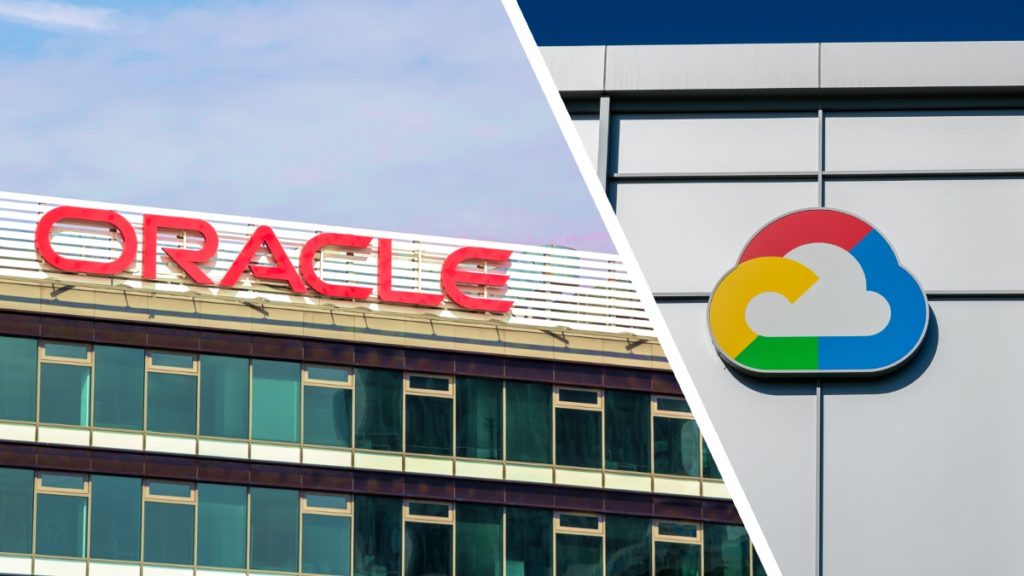
Following Oracle’s blockbuster multi-cloud deals with Microsoft and then AWS, I expect Oracle and Google Cloud to announce next month a sweeping multi-cloud partnership to give customers greatly expanded cloud-deployment choices.
I’m looking at this from the perspective of Oracle for a few different reasons:
- In a world that’s increasingly focused on data, Oracle is by far the world’s leading database provider. But its ability to maintain that status in the cloud is gated by its willingness and ability to make those databases available on whatever cloud infrastructure customers want to use.
- Oracle’s arrangements with first Microsoft and then AWS reveal Larry Ellison’s new-found passion for giving customers almost unlimited choices. The Microsoft multi-cloud deal is vast in scope, ambition, and impact — and not coincidentally was introduced with significant fanfare by both Ellison and Microsoft CEO Satya Nadella. (For full details, please see Larry Ellison and Satya Nadella Create the Multi-Cloud Future.)
- By contrast, the AWS arrangement is a straight commercial deal in which customers wanting to run Oracle’s MySQL HeatWave on their existing AWS infrastructure can do so via, in effect, Oracle’s AWS account, in which Oracle has become a paying customer of AWS. So, Oracle will no doubt offer Google Cloud a wide range of options for how the two companies might get this done.
- Customers are realizing that the balance of power in the IT buyer-seller equation has tilted forcefully — and permanently — away from the sellers and over to the buyers. Google Cloud has been taking big steps recently to showcase its wide-ranging multi-cloud ambitions, and in light of that, customers who want to run their Oracle workloads on Google Cloud infrastructure will not be too pleased if Google Cloud tells them they can’t do that.
On top of that, Oracle CloudWorld is taking place in Las Vegas October 17-20 and I believe Oracle would dearly love to be able to use that global showcase to announce that, on the heels of its multi-cloud embraces with Microsoft and AWS, it is also able to do the multi-cloud tango with Google Cloud.
But perhaps the biggest factor of all behind the likelihood of Oracle and Google Cloud forging a multi-cloud agreement is Larry Ellison himself. Here is one of the most intriguing comments I’ve ever heard from Ellison, which I included in a piece last week called Larry Ellison Meets Sun Tzu: Oracle Becomes AWS Customer to Boost Database Share:
“I know a lot of people for years have been concerned about whether Oracle can sustain its leading market share in the database business,” Ellison said on the earnings call.
“And I think what is now clear is if our databases are available in multiple clouds, then the answer is clearly yes. If our database is not available in multiple clouds, then it’s an interesting question whether we can maintain our lead just on our own cloud.”
Now, coming from someone who, many times over an extraordinary 45-year career, has proven himself to be one of the greatest business strategists the world has ever seen, that’s a pretty revealing comment. For Ellison to acknowledge the vulnerability of the ongoing leadership of the Oracle database franchise is probably unprecedented — yet here on a high-profile earnings call he offered it up as straightforward as could be: “If your database is not available in multiple clouds, then it’s an interesting question whether we can maintain our lead just on our own cloud.”
That’s what makes the first part of Ellison’s comment so important: “What is now clear is if our databases are available in multiple clouds, then the answer is clearly yes.” So, Ellison is unmistakably acknowledging that Oracle has an incredibly huge vested interest in forging multi-cloud agreements with all three dominant hyperscalers:
- Microsoft, which has been done in a big and broad and clearly mutually beneficial way;
- AWS, which has allowed Oracle to become a paying customer but otherwise seems unwilling to even acknowledge Oracle’s presence; and
- Google Cloud, which now sits comfortably and confidently in the catbird’s seat, clearly knowing that Oracle if not desperately then certainly passionately wants to do a multi-cloud deal.
Of course, Google Cloud stands to benefit quite nicely as well from such an arrangement. As the fastest-growing but also smallest of the three titans, Google Cloud cannot afford to be seen as being parochial or provincial in the multi-cloud game — in fact, the Oracle deals with Microsoft and AWS can indeed be seen as putting pressure on Google Cloud to avoid being perceived as the odd man (well, hyperscaler) out.
Recall, too, that Google Cloud CEO Thomas Kurian, who has led that company’s remarkable resurgence for the past four years, worked extremely close with Ellison for many years as Oracle’s head of software development before leaving in late 2018. No one but Kurian knows the precise reason for his decision to leave, but my guess is that there were two related but separate primary reasons: first, he wanted to be CEO of a high-growth, high-impact tech company. And second, Kurian believed Oracle was not willing back in late 2018 to play by the new rules of the cloud, where customer choice is paramount and was instead expecting customers to play by Oracle’s rules, which tilted strongly toward ‘buy everything from us.’
Again, that’s pure speculation, but I believe those two factors have at least some legitimacy. But here we are, four years after Kurian left Oracle, and I suspect he and Ellison have had a conversation or two about how they can collaborate to give their customers even more choices and options in what Ellison called “the multi-cloud era.”
Because occasionally in the Cloud Wars, truces and treaties are even more valuable than battles.








